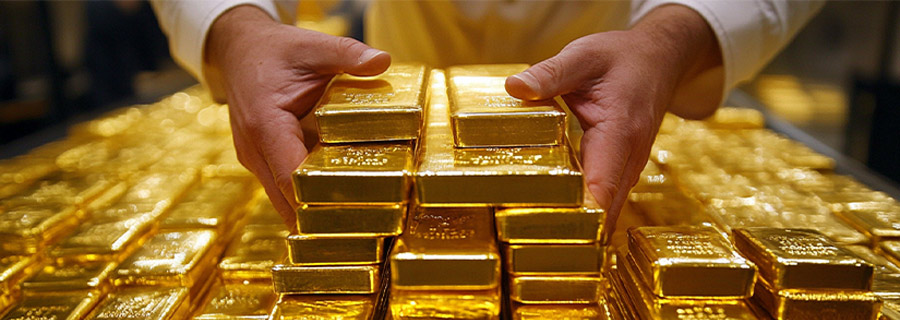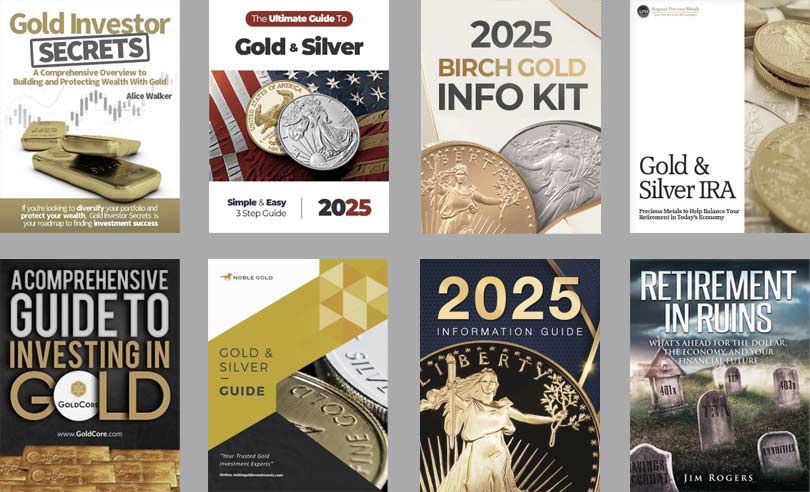
Gold hits a new all-time high (no Fed rate cuts required)
 Bullion.Directory precious metals analysis 17 September, 2024
Bullion.Directory precious metals analysis 17 September, 2024
By Peter Reagan
Financial Market Strategist at Birch Gold Group
That’s how much volatility to the upside we’ve seen – consecutive weeks of new price records, month after month. These days, lack of movement in gold’s price is more newsworthy.
So is the case now, as gold climbed near $2,600 late last week, a jump of some $100 compared to last Monday. In a well-established trend since the start of the year, analysts are scrambling to understand this latest move. (And, if you’ve been paying any attention to our publications so far this year, you’d be right in expecting they’re having a hard time with it.)
There has been no black swan event! Nothing obvious to tell stories about – so the consensus this time around is that gold price is responding to expectations of imminent Federal Reserve rate cuts. Except! As outlined here, rate cut expectations have actually decreased. Nine months ago at the start of the year, economists and analysts were expecting six rate cuts, which has since been dialed down considerably.
Indeed, with little more than three months left in the year, the Federal Reserve only has so much time left – and only three scheduled meetings. And then there’s the upcoming presidential election. The Fed couldn’t engage in an aggressive rate cut program right now without drawing the attention and the ire of the candidates.
Regardless, to interest rates: A 0.5% reduction is the expected figure now. The question is whether it will take the form of a single cut, two separate quarter-percent cuts or – possibly – a change of plan.
That’s right! We still don’t actually have any confirmation from the Fed itself, although hints have been there.
Most of the mainstream reports on the gold market make two mistakes:
- Refusing to acknowledge the fundamentals driving gold’s price higher
- Looking for a bear where there are none to be found
We will skip some of the more extreme examples and focus on the moderate. These two technical analyses, both published a day before gold leapt, make it sound as if gold is on rocky footing. The first says that “bullish bias” is keeping gold above $2,512, implying it should be lower based on… well, on something. The second makes it seem as if gold is stuck in a range it can’t get out of, again, just one day before a massive breakout.
When prices on any asset rise, it’s easy to point to upside risk. It’s easy to say gold is “overbought” – just look at the price! What’s hard is to tell a compelling story based on simple facts. Analysts and market watchers find it impossible to publish a column with a simple thesis like:
“The dynamic interaction of supply and demand drove gold’s price to _____.”
That’s the only story! Yes, sometimes there are interesting developments on the supply side. New mines open and old mines shut down. Sometimes there are interesting developments on the demand side (recently, a lot more of those). Record central bank gold buying, record demand from individual investors and so on.
Regardless, that’s the only story. And it’s a simple story. No matter how the analysts dress it up, price is a function of supply and demand.
It’s something to keep in mind when you’re reading after-action reports like this one.
Gold has already risen some 34% over the last 12 months – is there room for more? Well, yes there is.
$3,000/oz gold is the next big benchmark. We know it’s inevitable (the inflationary decay of our purchasing power makes this inevitable), but when? In the next 18 months? Before the end of the year? These are now considerations by those on the bullish-bullish side, with rate cuts in the U.S. and Europe being cited as forces likely to propel gold higher.
To those of you who already own physical gold, congratulations! You’re poised to benefit.
If you haven’t yet made up your mind to diversify with physical precious metals, I’d like to ask you a couple of questions:
What are you waiting for?
How far do you believe gold can fall from this point – will we ever see $1,800/oz. gold again?
Where do you expect prices to be 10 years from now? Lower? Or much, much higher…?
The Bank of France on gold’s “run for the ages”
Trying to figure out the innings of gold’s run has been messy business for some, but the Bank of France (BoF) tackled it recently. Before we delve into the analysis itself and how much of it we agree with, what immediately stands out is that the BoF says that gold has doubled in price since 2019.
Say what? But it’s true.
“The price of gold has doubled since 2019, with a notable acceleration in its increase in 2023. This rise is unexpected, given that rising real interest rates, a slowdown in inflation and a strong dollar should have dragged the price down. Purchases of gold by emerging market central banks and individual investors have bolstered demand, explaining the price increase, against a backdrop of high and persistent geopolitical tensions.”
You might be hard-pressed to remember that gold was as low as $1,275 early in 2019. We remember 2019 as the year that actually started gold’s current run, and we imagine most analysts will concur. This was back when the word “lockdown” wasn’t in common usage. So it’s a bit of a historical detail, that gold ran head first into the lockdowns while being on an unrelated run, and soaring up from there ever since.
Is this some kind of affirmation that $3,000 gold is bound to be a thing in the near future? We don’t know, but we like the idea.
Moving onto the analysis itself, BoF says that gold’s rise is “unexpected,” given that interest rates have risen, inflation has slowed down and the U.S. dollar shows strength. This already starts us off on a problematic course.
As we were heading into the current interest rate cutting cycle, we repeatedly pointed out to our readers that gold has gained in almost every hiking cycle to date. So the belief that rate hikes were going to end up being negative for gold was built on sentiment and completely against historical precedent, which is what tends to power gold bears anyways.
Besides that, we are left with the claim that inflation has been lowering and the U.S. dollar strengthening, which is what the official indices say. But does anyone feel it?
To explain what is going on, we either have to doubt gold or doubt the U.S. dollar. One of these things isn’t as described. It’s hard to misdescribe gold or sell it as something which it isn’t, leaving us with an obvious suspect.
Further in the analysis, the BoF says that the price move in the last four years appears to have been driven mainly by emerging market central bank gold buying. There is no secret that central banks have been an important pillar, but to attribute the bulk of gold’s price increases in the last four years to central banks alone? I don’t want to exclude the possibility, but if it is the case, there must be thousands of tons bought unreported every year to drive such a massive price swing.
If it is true, central banks are behind a much-needed return to the importance of the physical gold market. (This shows us just how irrelevant the “hypothetical gold” aka commodities market has become…)
Still, the analysis practically ignores so many points of relevant data that we ourselves wonder why. It should have an entire section on the global growth slowdown, with articles such as these being absolutely commonplace for those willing to look.
The analysis even compares the performance of gold in U.S. dollar terms to euro terms in a chart, showing that gold has very much kept up in the euro and even outperformed occasionally. So a deep currency crisis appears to be one of many reasons why gold is doing what it is, yet finding an admission that we are in one isn’t easy.
If nothing else, this analysis tells us a couple of important things:
- Yes, even the central banks of developed nations pay attention to gold’s price
- Even the most savvy analysts struggle to assemble a narrative about gold’s price beyond the dynamics of supply and demand
Speaking of central banks, there are more developments on that front…
Saudi Arabia’s central bank caught buying gold “off the record,” while Africa’s banks are more transparent
It seems that Saudi Arabia is one of many countries that have been less-than-transparent about their gold purchases as of late. Jan Nieuwenhuijs provides ample evidence that the Saudi central bank has bought 160 tons of gold since early 2022 in what seems to be an ongoing trend.
He mentions how the very same country that facilitated U.S. dollar hegemony through the petrodollar in the 1970s might end up spelling its demise. But let’s be real here.
Saudi Arabia is only one of many players on a chessboard that is taking the world financial system back to real assets that have a presence in the physical world: Gold, oil, silver and the like. Out of all the countries allegedly making secret gold purchases, Saudi Arabia has barely made the list so far. And there are many others.
No, the U.S. dollar’s demise, and with it by proxy the demise of any other free-floating currency along with their holders is a scheme with many more actors, albeit all mostly doing the same thing.
Outlining a method of under-the-radar purchases similar to that of China, Nieuwenhuijs notes:
“Just like the reported gold reserves by the PBoC, the number put out by [the Saudi Arabian Monetary Authority] SAMA is purely political. By hiding how much precious metal the nation truly owns, the House of Saud avoids openly upsetting the United States.”
In the same period, Nieuwenhuijs says that he calculated China bought as much as 1,600 tons of gold, including those months when Chinese official gold purchases were officially paused.
The last official update came between January and February of 2008, when Saudi Arabia’s central bank gold reserves went up by 180 tons in a month and remained static ever since. Nieuwenhuijs isn’t a believer that this was a monthly purchase and that was that, and neither are we.
These days, the gold hoards of both China and Russia are estimated to sit between 10,000 and 30,000 tons, with China’s being on the higher end. Since Saudi Arabia has been invited to a chair at the BRICS table, basic logic dictates that the country must sit on thousands of tons of unreported gold to command such a presence in the alliance.
The true number could be even higher.
Saudi Arabia is home to one of the “big two” overdeveloped Middle Eastern capital cities, Riyadh. The other is Dubai, United Arab Emirates, which has been considered by most as the primary buyer of discount Russian gold since the start of the invasion of Ukraine.
However much the UAE has, we can assume that Saudi Arabia has more.
Africa’s gold purchases have also been trending as of late for several reasons, a key one being that Africa is becoming increasingly interested in buying domestic gold rather than exporting it. Just like China, and just like Russia. So we will repeat a question we asked recently: if the main producers of new ore are all buying up their own stuff, where is the new gold going to come from?
As an additional note, let us remember that the reason the U.S. dollar enjoys its global reserve status is that our supposed 8,000 ton hoard is so much greater than that of any other nation. Sure, someone might want to get technical and say that is only half of the U.S. dollar hegemony, the other being the petrodollar. But since the second one ended recently, we are left with only the first.
These days, it not only looks like several countries not particularly aligned with the U.S. have a larger hoard, but that our own vaults are empty due to leasing.
If it does come, the long-awaited audit of Fort Knox might come during the worst time possible.
Peter Reagan

Peter Reagan is a financial market strategist at Birch Gold Group, one of America’s leading precious metals dealers, specializing in providing gold IRAs and retirement-focused precious metals portfolios.
Peter’s in-depth analysis and commentary is published across major investment portals, news channels, popular US conservative websites and most frequently on Birch Gold Group’s own website.
This article was originally published here











 Material provided on the Bullion.Directory website is strictly for informational purposes only. The content is developed from sources believed to be providing accurate information. No information on this website is intended as investment, tax or legal advice and must not be relied upon as such. Please consult legal or tax professionals for specific information regarding your individual situation. Precious metals carry risk and investors requiring advice should always consult a properly qualified advisor. Bullion.Directory, it's staff or affiliates do not accept any liability for loss, damages, or loss of profit resulting from readers investment decisions.
Material provided on the Bullion.Directory website is strictly for informational purposes only. The content is developed from sources believed to be providing accurate information. No information on this website is intended as investment, tax or legal advice and must not be relied upon as such. Please consult legal or tax professionals for specific information regarding your individual situation. Precious metals carry risk and investors requiring advice should always consult a properly qualified advisor. Bullion.Directory, it's staff or affiliates do not accept any liability for loss, damages, or loss of profit resulting from readers investment decisions.

Leave a Reply